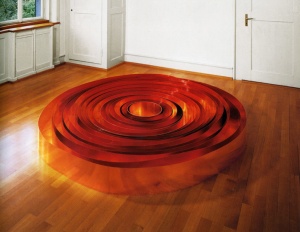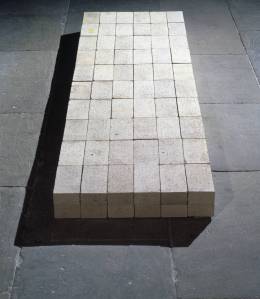“My art springs from my desire to have things in the world which would otherwise never be there.”
SYNOPSIS
During the 1960s and 1970s, Carl Andre produced a number of sculptures which are now counted among the most innovative of his generation. Along with figures such as Donald Judd, Sol LeWitt, Dan Flavin, Eva Hesse and Robert Morris, Andre played a central role in defining the nature of Minimalist Art. His most significant contribution was to distance sculpture from processes of carving, modeling, or constructing, and to make works that simply involved sorting and placing. Before him, few had imagined that sculpture could consist of ordinary, factory-finished raw materials, arranged into straightforward configurations and set directly on the ground. In fact, during the 1960s and 1970s many of his low-lying, segmented works came to redefine for a new generation of artists the very nature of sculpture itself.
KEY IDEAS
CARL ANDRE BIOGRAPHY
Childhood
Andre has always credited his early upbringing in Quincy, Massachusetts, as having a formative influence on his art. The son of a marine architect of Swedish descent, he grew up in close proximity to the Quincy naval shipyards, which during the Second World War expanded rapidly (at their peak of productivity they employed 32,000 workers). He would later claim that one of his strongest childhood memories had been the sight of the “rusting acres of steel plates” which lay beside the yards “under the rain and sun.”
In 1951, at the age of 16, Andre was awarded a scholarship to attend Phillips Academy, the prestigious boarding school in Andover, Massachusetts. It was here, under the tutelage of the painters Maud and Patrick Morgan, that he received his only formal art training.
LEGACY
From the late 1960s onwards, Andre’s art became an important reference point for many subsequent artists both in North America and in Western Europe – largely because he was seen to have reduced sculpture to its essential state. While Andre himself saw this as the end-point of his art, many sculptors (including Richard Serra) took his insights as the starting-point for their own practice, and built up from the principles which Andre had laid down.
CARL ANDRE QUOTES
“Art is the exclusion of the unnecessary.”
“Settle for nothing less than concrete analysis of concrete situations leading to concrete actions.”
“My art will reflect not necessarily conscious politics but the unanalyzed politics of my life.”
“…art for art’s sake is ridiculous. Art is for the sake of one’s needs.”


